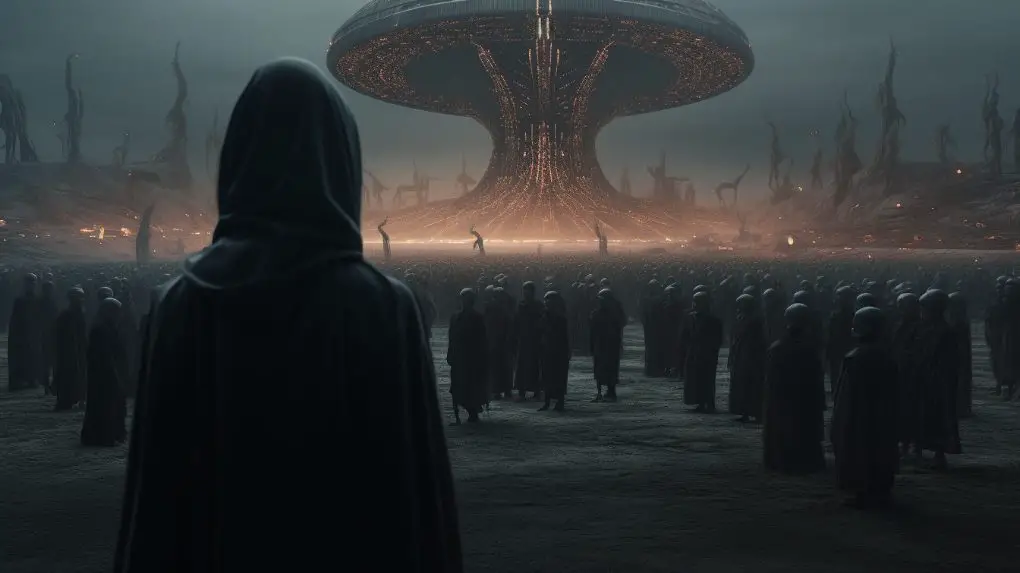In the vast cosmos of human belief, UFO religions emerge as a testament to our endless quest for connection with the universe’s deepest mysteries.
These unconventional paths to spirituality weave tales of extraterrestrial interactions with ancient lore, inviting readers to explore how our understanding of life and realm beyond has given rise to these captivating belief systems. Embark on this cosmic journey through the lens of ufology and unravel the intricate beliefs that millions find otherworldly comfort in.
Introduction to UFO Religions
UFO religions, often categorized as new religious movements, are faith-based communities centered around the belief and often worship of extraterrestrial entities associated with unidentified flying objects (UFOs).
These groups vary widely in their structures, doctrines, and rituals, but they share a common thread: the conviction that life exists beyond Earth and that these extraterrestrial beings have a specific interest or role in humanity’s past, present, and future.
The Emergence of UFO Religions in History
The phenomenon of UFO religions has historical roots deep in the human past, where ancient civilizations depicted celestial events and “heavenly” visitors using their cultural lenses. These narratives have evolved, particularly during the 20th century when a significant surge in UFO sightings occurred. This era marked a turning point, with numerous individuals and groups interpreting these experiences through a religious framework, thereby formalizing the foundations of several UFO religions.
Defining UFO Religions: Beliefs and Practices
UFO religions are characterized by a diverse range of beliefs, often centered around communications with extraterrestrial beings—deemed as advanced spiritual entities or space-age messiahs—capable of providing humanity with wisdom and technological advancements.
Practices within these religions are equally varied, ranging from meditation to establish cosmic connections, to preparing for a collective ascension to another planet. The central tenet, however, remains the existence of life beyond Earth and its interaction with humanity.
Related: Are We Aliens? – Pondering Our Origin Through Mythology And Ancient Religion
The Historical Context of UFO Religions
The cultural and historical contexts from which UFO religions emerged are crucial to understanding their appeal and proliferation. The sightings of mysterious objects in the sky have influenced art, literature, and spiritual beliefs throughout history, suggesting a long-standing human fascination with the heavens and the possibilities they hold.
Ancient Aliens and Historical Texts
The concept of ‘ancient aliens’ or ‘ancient astronauts,’ popularized in the late 20th century, suggests that extraterrestrial visitors have influenced human civilization for millennia. Proponents argue that historical texts, megalithic structures, and ancient artworks provide evidence of this past contact.
This perspective has significantly influenced various UFO religions, with believers often citing these ancient connections as proof of a historical relationship between human beings and extraterrestrial life.
The Space Age: A Catalyst for UFO Religions
The onset of the Space Age, marked by significant advancements in space exploration during the mid-20th century, served as a catalyst for the formation and growth of UFO religions. The world’s collective gaze turned skyward, leading to increased speculation about extraterrestrial life.
In this context, UFO sightings became more common, and popular culture reflected a growing interest in aliens and space travel. These developments provided fertile ground for new religions to take root, with several UFO religious movements tracing their origins to this era.
The Religious Impulse and Extraterrestrial Life
The religious impulse in human beings extends beyond traditional earth-bound deities, reaching for the cosmos and the mysteries it holds. This innate tendency to seek connections with a profound ‘other’ potentially explains the appeal of extraterrestrial entities as objects of religious veneration.
Human Beings’ Religious Engagement with the Universe
Religious engagement with the universe involves perceiving cosmic phenomena through a spiritual lens, interpreting these events as materially and spiritually significant. UFO religions tap into this engagement, suggesting a grander cosmic plan or intervention woven into the fabric of human destiny. This perception elevates the importance of human-extraterrestrial interactions, presenting them as crucial for humanity’s spiritual evolution or survival.
The Quasi-Religious Relationship People Maintain with UFOs
The relationship between individuals and UFO phenomena often transcends mere curiosity or fear, entering the realm of personal belief and spiritual meaning. For some, UFO experiences represent a form of enlightenment or a catalyst for understanding a higher purpose. This quasi-religious relationship is characterized by a reverence for the knowledge and technological prowess attributed to extraterrestrial beings, often seen as saviors or harbingers of planetary change.
Also read Aliens On Earth – Examining Stories Of An Alien Presence On This Planet
Case Studies in UFO Religions
UFO religions across the globe offer insight into the diverse ways cultural contexts shape the interpretation of extraterrestrial encounters. These case studies illustrate the spectrum of beliefs and practices within these movements.
Studies in North American Religion: America’s UFO Religion
In the American context, UFO religions emerged amidst the Cold War anxieties, reflecting societal fears and hopes. Movements such as Unarius Academy of Science and the Aetherius Society gained traction by offering alternative spiritualities that intertwined with popular science fiction narratives. These religions, while diverse, often share themes of impending global crisis and extraterrestrial salvation, echoing broader cultural and societal concerns.
The Aetherius Society: A Syncretic Fusion
The Aetherius Society exemplifies syncretism in UFO religions, combining elements of eastern and western spiritual traditions with a belief in cosmic masters from other planets. Founded by George King in the 1950s, the society promotes peace and goodwill, emphasizing the importance of spiritual energy in preventing global catastrophe. Their practices, including prayer, healing, and energy manipulation, reflect a blend of traditional religious rituals and New Age concepts, all centered around guidance from extraterrestrial intelligences.
Heaven’s Gate: A Cautionary Tale
Heaven’s Gate, founded by Marshall Applewhite and Bonnie Nettles in the 1970s, stands as a cautionary tale in the study of UFO religions. Members believed in a hierarchy of extraterrestrial beings and sought to transcend their physical existence by reaching an alien spacecraft following the Hale-Bopp comet. The group’s tragic end in a mass suicide highlights the potential dangers of charismatic leadership and apocalyptic narratives within such movements.
The Raelian Movement: Embodiment of the Space Age
The Raelian Movement, founded in the 1970s by Claude Vorilhon (Rael), presents a utopian vision of a future transformed by science and technology. Raelians advocate for societal reform and embrace controversial stances on sexuality, cloning, and artificial intelligence. Their belief system, centered around extraterrestrial creators called the Elohim, epitomizes the Space Age’s influence, blending science fiction with promises of a revolutionary future.
Global Perspectives on UFO Religions
While UFO religions have a noticeable presence in Western cultures, particularly in America, their influence and manifestation are indeed global. Different cultural backgrounds and historical contexts have given rise to unique expressions of UFO religions around the world.
UFO Religions Emerging Worldwide
The phenomenon of UFO religions is not confined to Western culture. From the remote villages of Africa to the technologically advanced cities of Asia, stories of unidentified flying objects leading to new religious movements have emerged. In each locale, these religions morph to reflect local myths, anxieties, and hopes for the future, demonstrating the adaptability of the UFO narrative.
South Korea: A Unique Religious Movement
In South Korea, the convergence of rapid technological advancement and deep-rooted spiritual beliefs has fostered a unique environment for UFO religions. Groups such as the Cosmic True Parents of Heaven and Earth blend Confucian principles, Christian eschatology, and contactee narratives to form a complex belief system that resonates with local cultural dynamics. These movements often emphasize harmony between cosmic beings and the natural world, reflecting broader societal values.
Hindu Ufology: A Different Interpretation
In India, interpretations of ancient Vedic texts have given rise to beliefs in advanced extraterrestrial civilizations that once visited Earth. Hindu ufology considers iconic religious figures and detailed accounts of flying machines or ‘Vimanas’ as indicative of early encounters with extraterrestrials. Unlike Western counterparts, these beliefs don’t always coalesce into organized movements but permeate popular spirituality and folklore, suggesting a cultural synthesis of religious history and extraterrestrial speculation.
Analyzing Contemporary UFO Religions
Modern UFO religions operate in a world where the lines between science, religion, and entertainment often blur. These movements interact with contemporary culture, incorporating everything from conspiracy theories to emerging technologies, molding their doctrines to suit the changing times.
The Role of Popular Culture and Media
Popular culture and media have played significant roles in disseminating UFO narratives. Television shows, movies, and books often explore themes of alien contact and abduction, shaping public perception and curiosity regarding these phenomena. For UFO religions, this cultural landscape creates a fertile ground for attracting followers, offering a framework that makes extraterrestrial belief systems more palatable and relatable to the mainstream audience.
Conspiracy Theories and the UFO Phenomena
Conspiracy theories are inextricably linked with the UFO phenomena, often providing alternative explanations for government secrecy and advanced technology. These theories, ranging from elaborate government cover-ups to alien bases on Earth, feed into the mythology of UFO religions. They often serve to validate believers’ claims, offering a grander narrative in which the hidden truth is accessible only to the enlightened or chosen ones.
Abduction Narratives: Impact on Believers
Abduction narratives, where individuals claim to have been taken and sometimes experimented on by aliens, contribute significantly to UFO religions. These personal testimonies offer intimate encounters with the ‘divine,’ paralleling historical religious experiences. Such narratives often carry deep psychological and spiritual impact, reinforcing a personal and sometimes prophetic connection with the extraterrestrial beings worshipped or revered within these groups.
Academic and Theological Scrutiny
UFO religions have not escaped the attention of academics, theologians, and skeptics, all of whom have scrutinized these movements from various angles. The study of these religions sheds light on broader human concerns about existence, spirituality, and the future of humanity.
The Bloomsbury Companion to New Religious Movements
Resources like “The Bloomsbury Companion to New Religious Movements” provide comprehensive insights into the foundation, evolution, and current state of UFO religions. Contributions from various scholars in this work delve into the sociological, theological, and cultural aspects of these groups, highlighting their significance in contemporary religious landscape.
Lake Forest College’s Focus
Lake Forest College, through its religious studies department, has made notable contributions to the study of contemporary religion. With a dedicated team, including the likes of associate professor Michael Ashcraft, the institution has explored the complexities of belief systems that deviate from mainstream world religions. Their research often focuses on individual proponents and the sociological implications of UFO religions.
Karen Swartz: Co-Editor and Researcher
Karen Swartz, known for her extensive research in new religious movements, offers an analytical perspective on the dynamics within UFO religions. Her work, often in collaboration with other academics, dissects the psychological, cultural, and sometimes political elements that influence the followers of these movements. Swartz’s contributions extend beyond academia, with her informed critiques providing a balanced view on a subject often marred by sensationalism.
You may also like Books About Aliens – Recommended Reads For People Who Want To Know More About ETs
Syncretistic Components in UFO Religions
UFO religions frequently exhibit syncretism, blending beliefs, and practices from various religious traditions with lore about extraterrestrial life. This fusion results in a rich tapestry that resonates with followers from diverse religious backgrounds, enhancing the universal appeal of these movements.
The Melting Pot of Ideas
UFO religions represent a melting pot of ideas, drawing from established religions such as Christianity, Hinduism, and numerous New Age practices. This syncretism allows them to tap into familiar symbols and archetypes, repurposing them within a narrative that encompasses extraterrestrial dimensions. The Virgin Mary or Krishna, for instance, may be reinterpreted as extraterrestrial beings, providing a bridge between the known and the unfathomable.
Science and Spirituality: The Dance Continues
The interplay between science and spirituality is a hallmark of UFO religions. They adopt scientific jargon and concepts, particularly from astronomy and physics, to provide legitimacy and modern relevance to their beliefs. Concepts like multidimensional realities, quantum consciousness, and advanced extraterrestrial technologies are woven into theological doctrines, presenting a universe where science and faith coexist and enhance each other.
Conclusion: Understanding UFO Religions in the Modern World
UFO religions offer a fascinating study in the evolution of belief, showcasing humanity’s perpetual quest to understand its place in the cosmos. These movements, while often marginalized, speak to enduring questions of existence, utilizing the imagery and promise of extraterrestrial contact to craft narratives of hope, salvation, and transcendence.
Through their syncretistic nature and adept use of popular culture, UFO religions remain a noteworthy phenomenon in the religious studies. They challenge the boundaries of traditional faiths and potentially foreshadow the emergence of new forms of spirituality aligned with humanity’s growing understanding of the universe. As we continue to ponder our existence and reach for the stars, the allure of the unknown ensures that these religions, and the questions they pose, will endure.
Don't miss Aliens Are Demons – Investigating The Belief Of Some That UFOS Are Satanic Entities
Recommended Further Reading:
Auto Amazon Links: No products found.



